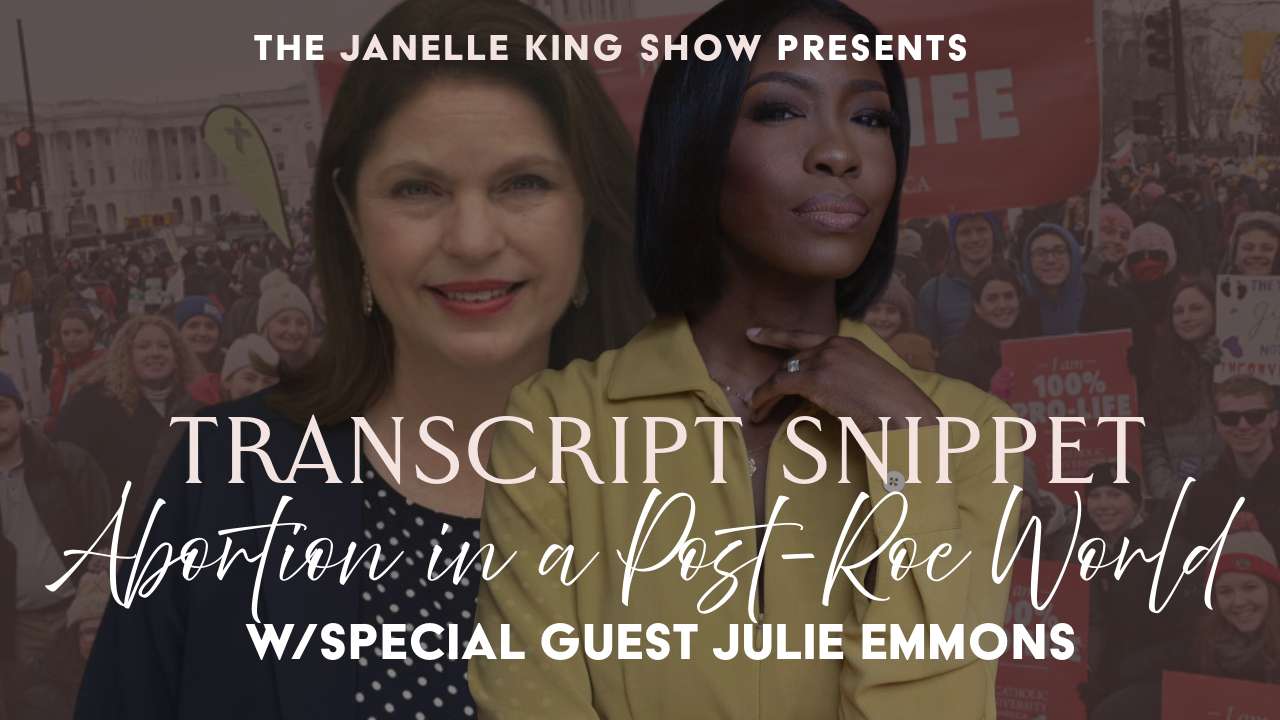
Abortion in a Post-Roe World
The overturning of Roe v. Wade marks a seismic shift in reproductive rights in the United States, revoking the federal protection for abortion rights established in 1973 and returning the power to regulate abortion to individual states. This landmark Supreme Court decision has deepened the divide between pro-choice and pro-life advocates, with supporters arguing it corrects a constitutional overreach and protects unborn lives, while opponents warn of the dire consequences for women’s health and autonomy. The resulting patchwork of state laws, ranging from heavy restrictions to expanded access, is set to reshape the national discourse and impact millions of lives, making this a transformative moment for women’s rights and personal autonomy in America.
In this article, we delve into a snippet of my conversation with Julie Emmons from the Human Coalition as we explore the critical issues surrounding abortion in a post-Roe v. Wade world. Julie shares her perspectives on the role of elected officials supporting the abortion pill, the impact of recent legislative changes, and the ongoing efforts to support women and families.
[Below, you’ll find an edited snippet from our conversation, streamlined for clarity and ease of reading. This excerpt is taken from various parts of the discussion, not necessarily from the beginning.]
Enjoy!
Julie Emmons: Right, right, it is. While there are surgical abortions, up to two-thirds of all abortions are currently medical or chemical abortions, which involve the abortion pill. To be clear, it’s not just one pill but a series of pills taken over a period of days. It’s similar to how you might be prescribed a regimen of steroids or antibiotics. The process involves two different pills. The first one is called mifepristone, and it blocks progesterone, the hormone necessary for pregnancy to continue
Julie Emmons: in the woman’s body from reaching the child, essentially causing the death of the child. Then, you have your second pill, if it’s a prostaglandin…
Julie Emmons: so it’s a multi-day process. It’s not [like] taking a Tylenol,…
Julie Emmons: which is what a lot of times women are told, this is just nothing,…
Julie Emmons: you’ll be fine.
Julie Emmons: An excruciating pain the risk of hemorrhage the risk of complications.
Janelle King: who has been able to get this pill without the doctor knowing…
Janelle King: Why is it so dangerous?
Julie Emmons: She has a one in four chance of needing follow-up care at an emergency room. Never heard of that happening with a Tylenol. this is it and the thing is she’s by herself in many cases and she’s in her home. So this is in many cases. She’s alone at home.
Julie Emmons: She doesn’t know who to call if she has issues. She might end up in a local emergency room. In some cases, she’s been told to tell no one she has taken the pill so that the follow-up doctor doesn’t know what they’re really dealing with they feel like they’re dealing maybe with a miscarriage complication when they’re not so the abortion pill
Julie Emmons: It was first approved by the FDA years ago and…
Julie Emmons: That leads me to the Supreme Court case in March. If you don’t mind, I’d like to discuss it. When the FDA first approved this, they implemented safeguards that were really just common sense. The FDA’s job is to keep us safe, and initially, it required the medication to be prescribed by a doctor in a medical clinic. Additionally, they needed to confirm that the pregnancy was in the uterus and not an ectopic pregnancy in the fallopian tube.
Janelle King: right
Julie Emmons: All these different things needed follow-up care, and it was only approved up to a certain number of weeks of gestation. Slowly but surely, those safeguards and regulations started getting rolled back, with sentiments like “maybe we don’t need that” or “we don’t need this.” Then, COVID hits, and suddenly, you can just prescribe it through Telehealth.
Julie Emmons: You don’t even need to see the mom or confirm that the baby is in the uterus. You don’t need to verify if she is nine weeks along rather than 13.
Julie Emmons: Absolutely, all the time. It’s no longer required. When this whole house of safeguards fell down, a group of pro-life doctors sued. They argued that the FDA had approved the pill without properly studying its safety and without the necessary safeguards. This is irresponsible. The case went to the Supreme Court, and I was there for the hearing in March. It was interesting to see the boldness, almost the glee, of the abortion industry in taking the lives of these children. It seems to have reached a new height.
I hope you’ve enjoyed this snippet of my discussion with Julie Emmons. To hear the entire interview, please click on the link below. https://youtu.be/r0a-f3uGTQU

Go tell your propaganda-spewing guest to learn how to do research.. A 3 second Google search would have told her that Tylenol overdoses account for more than 50,000 ER visits per year. In fact it’s the leading cause of acute liver failure in the US.
But I get it, all she cares about is controlling other women’s lives in the name of an imaginary deity.